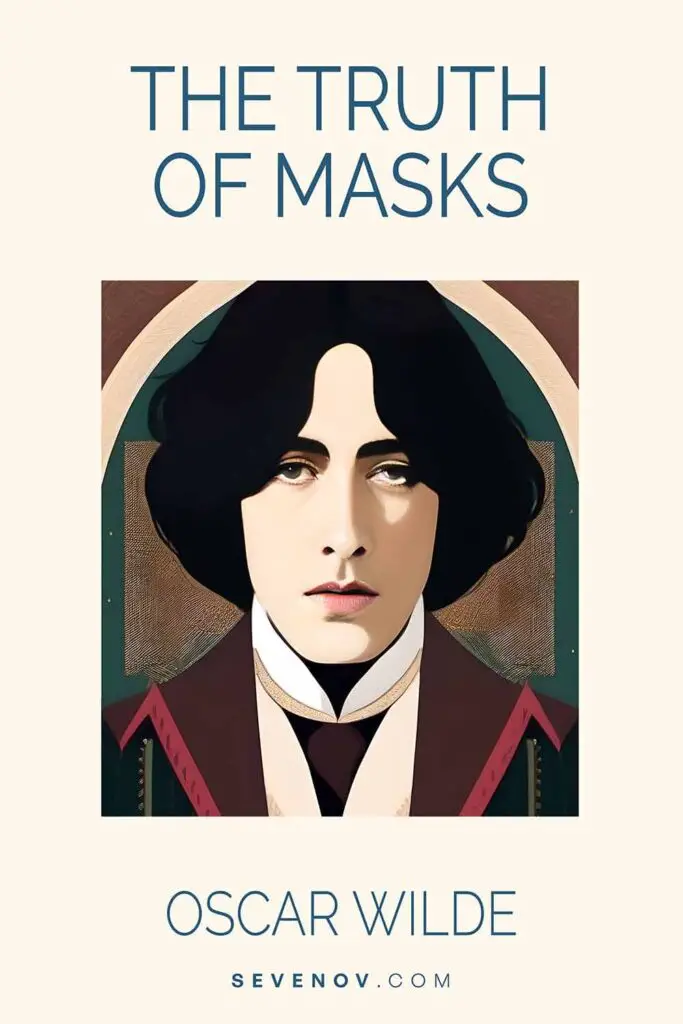
The Truth of Masks by Oscar Wilde
Author: Oscar Wilde
Published: 1891
Genre: Non-fiction, Essay
“The Truth of Masks” is an essay written by celebrated playwright Oscar Wilde, and first published in 1891 as part of Wilde’s collection of essays titled Intentions. It explores the significance of historical accuracy and artistic unity in costume design for theatrical productions, challenging conventional ideas of realism on the stage.
1. The Truth of Masks Introduction
“The Truth of Masks” delves into the intricate relationship between art, historical accuracy, and the role of costumes in theatrical productions. Wilde’s captivating exploration challenges traditional notions of realism and authenticity on the stage, emphasizing the importance of archaic accuracy and artistic unity in costume design. In this thought-provoking essay, Wilde argues that the right costumes not only create a visual spectacle but also enhance the overall impact and message of a play, making it a vital component of the theatrical experience. Wilde’s insights in “The Truth of Masks” provide a unique perspective on the artistic principles that underpin stagecraft, inviting readers to reconsider the significant role costumes play in bringing characters and narratives to life.
2. The Truth of Masks Summary
The essay discusses the importance of costume and historical accuracy in theatrical productions, particularly in the context of Shakespeare’s plays. It begins by addressing the criticism that Shakespeare himself was indifferent to the costumes of his actors. Wilde argues against this notion, emphasizing Shakespeare’s use of costume as a means of achieving dramatic effects and enhancing the illusion of the play. He mentions instances where the choice of clothing was crucial to the development of the plot and characterization in plays like “Measure for Measure,” “Twelfth Night,” and “The Merry Wives of Windsor.”
Furthermore, Wilde highlights how small details of dress, such as the color of stockings or the pattern on a handkerchief, played a role in conveying character traits and advancing the plot. Costumes are used to express character traits, intensify situations, and even provide metaphors within the dialogue. Wilde emphasizes that Shakespeare was meticulous in his instructions regarding costumes, and he saw costume as a means to produce specific dramatic effects. It notes how certain scenes, characters, and dialogues in Shakespeare’s plays were directly inspired by or related to clothing.
Wilde also discusses the resources available to Shakespeare in terms of costume design and production during his time. There is an inventory of a London theatre’s costume wardrobe from Shakespeare’s era, demonstrating the attention to detail and variety of costumes available.
Wilde discusses the historical context of the Renaissance period and how the interest in archaic and foreign dress influenced theatrical productions. This interest in historical costumes was not limited to scholarly research but extended to practical use in plays, masques, and pageants. He argues that the stage is a platform where archaeology can be made beautiful and vivid by combining the study of historical costumes with artistic expression.
The essay also mentions the importance of determining the correct historical period for each play and using this as a basis for designing costumes and scenery. It highlights the role of the archeologist in providing historical accuracy and materials for the artist to transform into visually stunning effects on stage. Wilde emphasizes that archeology is a valuable tool for theatrical productions when used by artists to enhance the overall experience and atmosphere of a play.
The essay highlights that knowledge of historical clothing wasn’t solely derived from books but also from foreign travel, increased global trade, and diplomatic missions, providing opportunities to study different contemporary dress forms. Shakespeare’s plays, for instance, often incorporated the attire of foreign visitors and historical periods. The essay suggests that this attention to accurate costuming contributes to the overall effectiveness of a theatrical performance.
Wilde mentions that Shakespeare’s historical accuracy extended beyond costume to the plots and personages of his plays. He drew inspiration from authentic history and old ballads, creating characters that reflected the characteristics and social atmospheres of their respective eras. The accuracy of historical details was crucial to Shakespeare’s work, as it helped immerse the audience in the world of the play.
The essay also discusses the importance of unity in theatrical production, with one mastermind directing the entire process, from costume design to stage setting. It argues that the stage’s color scheme and costume choices should harmonize to create a visually pleasing and coherent overall picture. The content highlights the importance of archeological accuracy, appropriate design, and beautiful colors in achieving this unity.
Additionally, Wilde addresses the need for actors to feel comfortable and natural in their costumes to deliver convincing performances. It suggests that more dress rehearsals are essential for actors to become accustomed to their attire, enabling them to embody their characters more effectively. Moreover, the essay argues that beautiful costumes can enhance the audience’s appreciation of art and beauty for its own sake. It mentions Shakespeare’s use of artificial lighting and a darkened theatre to create an atmosphere conducive to artistic perception.
The essay concludes by emphasizing the value of beautiful costumes in evoking an artistic response from the audience and creating a sense of joy in beauty for its own sake. It acknowledges that the pursuit of this artistic ideal may be challenging, but it is worth the effort. Finally, Wilde calls for critics to encourage, rather than oppose, the integration of archeology and accurate costume design in modern theater.
3. Conclusion
If you’re interested in delving deeper into Oscar Wilde’s thoughts on costume design for theater, you can explore the full version of “The Truth of Masks” online. It offers valuable insights into Wilde’s perspective on the significance of costumes in dramatic productions, making it a fascinating read for anyone passionate about the world of theater and its intricacies.




